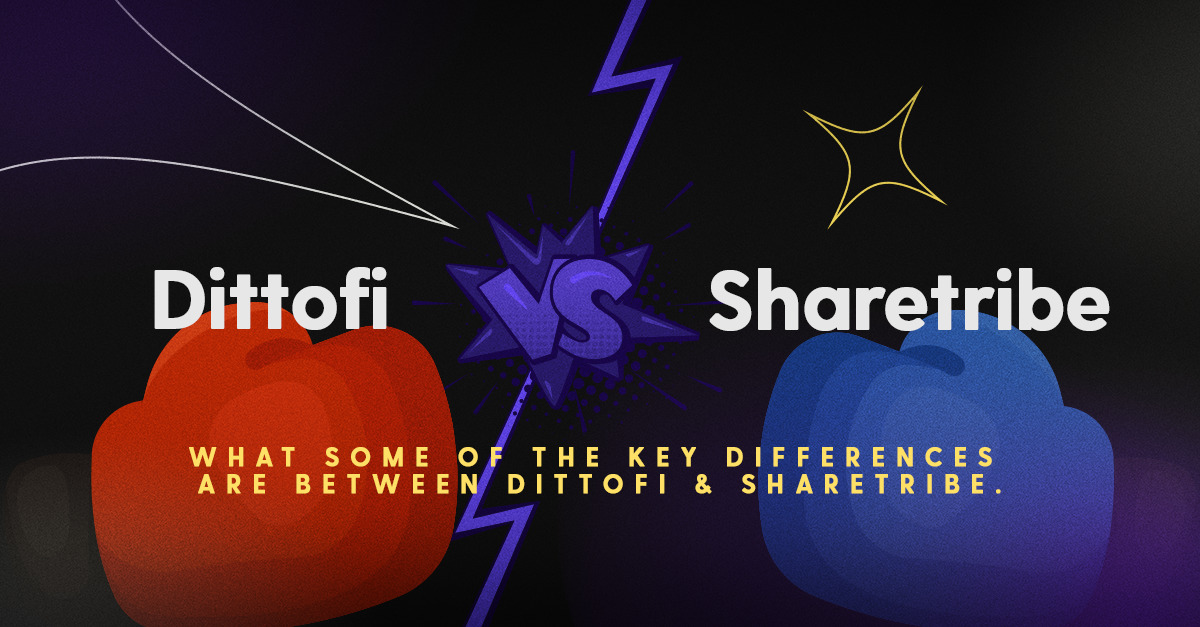Both Sharetribe and Dittofi offer specialist marketplace technology.
Both platforms can be used to build different types of marketplace including as B2C, peer to peer and B2B marketplaces.
In this article we look at what are some of the key similarities and differences are between Dittofi and Sharetribe. This will help you decide which marketplace technology is best to use for your development.
What is Sharetribe?
At a high level, Sharetribe is a website builder for entrepreneurs to create two-sided marketplace sites similar to Etsy, Fiverr and Airbnb.
Sharetribe offers two primary solutions: Sharetribe Go & Sharetribe Flex.
- Sharetribe Go. A visual interface for users to get build a marketplace. The marketplace is not that customizable however it does allow you to quickly spin up a marketplace that you can use to test a new marketplace idea.
- Sharetribe Flex. Sharetribe Flex is a developer-first solution that allows developers to build custom web or mobile frontends on top of Sharetribe’s marketplace API. To use this solution, you will need to be familiar with coding or to hire a developer.
Who is Sharetribe for?
Sharetribe Go targets startups who want to validate an idea for a new online marketplace. The marketplaces can be either:
The solution offers a form based setup, where marketplace founders can answer questions about their marketplace. For example, users can specify the type of marketplace, marketplace name, country of operations, primary currency and so on. A screenshot of this form based approach is shown below.
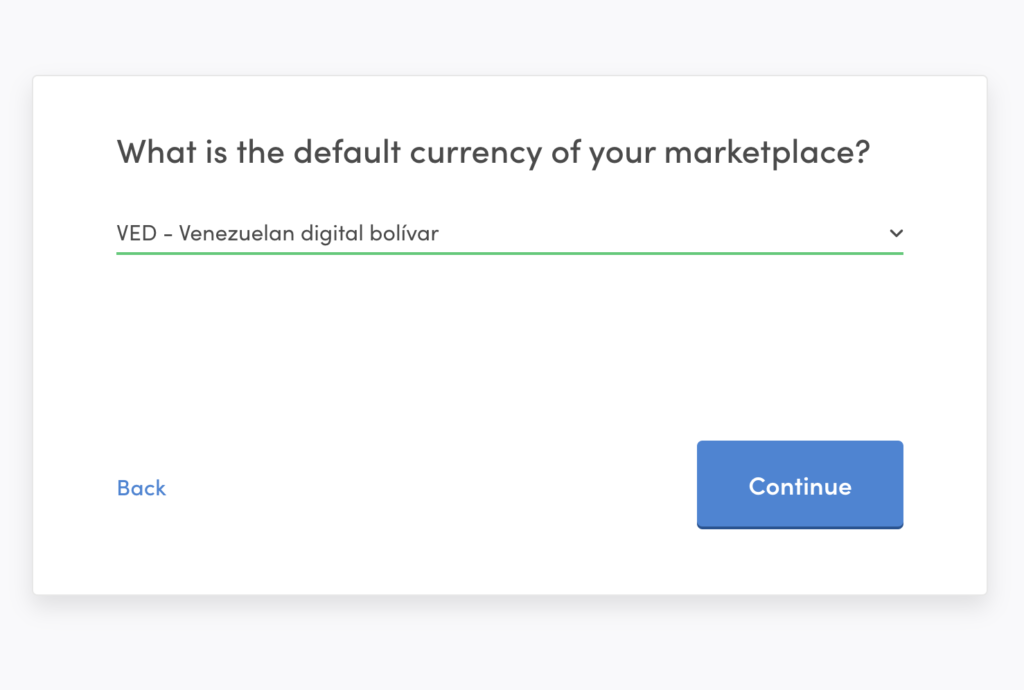
Once the initial forms have been filled in, Sharetribe then gives users a dashboard from where to configure their marketplace settings.
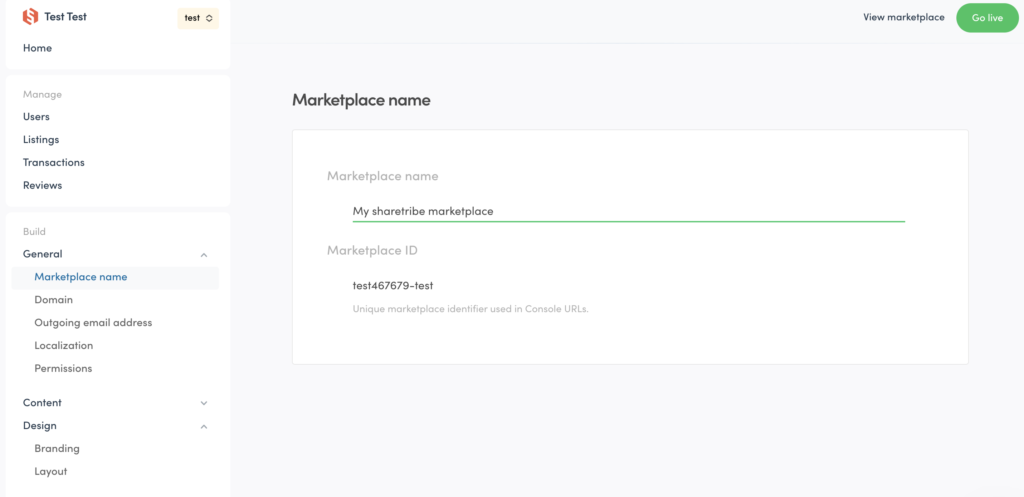
Sharetribe uses the inputs shown above to help you configure their marketplace template. Although it is quick and easy to get started, Sharetribe Go allows for very limited customization. Below is an example of what you can expect when using Sharetribe Go.
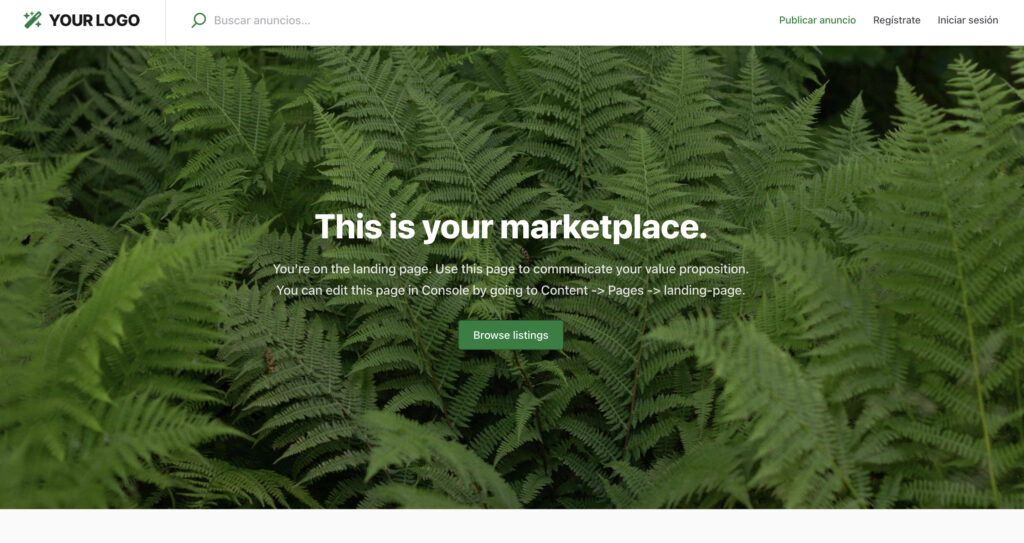
Limited customization is not a major cause for concern since, the idea of Sharetribe Go is to simply validate your marketplace idea. The expectation is that you will hire developers to customize your marketplace with Sharetribe Flex if and when you validate your marketplace idea.
That being said, it would be nice if you could customize your marketplace aesthetics with a little more freedom than is given by the Sharetribe platform. In addition to this Sharetribe’s template does not support other key marketplace features such as:
- Reverse marketplaces
- Certain marketplace business models
- And so on.
Dittofi vs Sharetribe
Similar to Sharetribe, Dittofi offers marketplace creators a suite of carefully designed product, service and rental marketplace templates. Each template can be installed into Dittofi’s visual development studio from where it can be customized with 100% flexibility and without any coding. Below is an example of Dittofi’s rental marketplace template inside of Dittofi’s visual development studio.
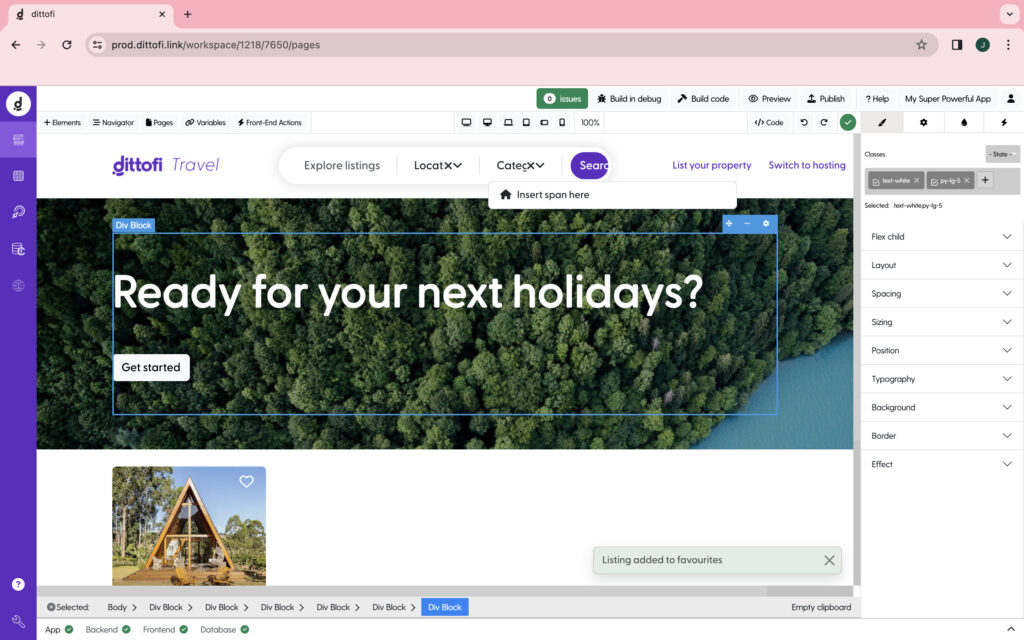
At its core, Dittofi is a hybrid no code platform. This means that it is able to take visual edits that you make to your marketplace and transform these changes into quality code (React and Google Go) that you can access, edit and own. Code for your marketplace can be deployed in a single click into Dittofi’s marketplace hosting or exported and handed off to a developer.
The table below is a comparison between Dittofi, Sharetribe Go and Sharetribe Flex.
Dittofi vs Sharetribe: Comparison Table
| Marketplace Builder | Dittofi | Sharetribe Go | Sharetribe Flex |
|---|---|---|---|
| Dedicated marketplace solution | Yes - Dittofi has a suite of customiztable product, service & rental marketplace templtaes | Yes - get a non-customizable product & rental marketplace template. | Yes & No - use the fixed product & rental marketplace backend & hire a developer to code your marketplace frontend. |
| Time to launch | 1 week | 1 week | 3 - 6 months |
| Level of customization | Entirely customize using Dittofi's visual development studio. | Non-customizable | Code custom frontends from scratch & plug these into the fixed backend. Extend parts of the backend with code. |
| Own your code & IP | Yes - export HTML, CSS, JavaScript Google GO & SQL code | No - you cannot own your marketplace code or IP | No - you cannot own your marketplace code or IP. |
| Technology stack | Modern stack (React on the frontend, Google Go on the backend). | N/A | Backend only & runs on an older, less performant tech stack (Ruby on Rails). |
| Marketplace training | Yes - extensive blogs & video training showing how to build simple to complex two-sided marketplace apps. | Yes - extensive blogs discussing marketplace development. | Yes - extensive blogs discussing marketplace development & API documentation to explain Sharetribe Flex. |
| App hosting | Cloud agnostic - host with Dittofi, GCP, AWS Azure or any other provider. | Locked-in to hosting with Sharetribe. | Locked-in to hosting with Sharetribe. |
| Security | Best practice security built into your app at code & infrastructure levels.
Own your infrastructure & customise your security policies with 100% flexibility. . |
A “one size fits all” approach to security. | A “one size fits all” approach to security. |
| Pricing | Plans start from $49.99 (includes full source code export). Demand based pricing for hosted solution. |
Plans starting from $79 /mo
(Custom Landing Page $99 /mo). Fixed pricing for hosting not appropriate for seaonsal marketplace businesses - or for early stage startups still developing more consistent traction. |
Subscription fee $299 /mo
(+ Transaction fee for transaction volume over $30,000). Fixed pricing for hosting not appropriate for seaonsal marketplace businesses - or for early stage startups still developing more consistent traction. |
Note* Sharetribe offers their backend code as a Ruby on the Rails open source solution for developers.
Let’s take a closer look at some of the similarities & differences between Dittofi, Sharetribe Go & Sharetribe Flex.
Similarities between Sharetribe and Dittofi
Both Sharetribe and Dittofi are examples of specialist marketplace technology. that enable users to build mobile responsive, peer to peer marketplaces. Both platforms come with extensive training materials tailored for the development of two-sided marketplaces.
Both Sharetribe and Dittofi also allow for easy team collaboration, the ability to track end user behavior with the use of Google Analytics and the option to own the source code for your marketplace.
Key differences between Sharetribe and Dittofi
The main difference between Dittofi and Sharetribe is that Dittofi is a hybrid no-code platform targeted towards users who want to quickly build and launch a new marketplace, customize the solution based on user feedback and then scale up usage. This means that Dittofi comes with a full suite of visual development tools that can help you launch fast and then rapidly customize and scale up without coding.
In contrast, Sharetribe is primarily focused on startups and SMEs looking to test new marketplace ideas. After you’ve tested your initial concept, Sharetribe then require you to hire a development team in order to make any updates to your marketplace. At this point you will be working with engineers who are expensive and slow to modify your solution.
In this section we dive deep into the key differences between Dittofi & Sharetribe. We will compare Dittofi and Sharetribe in the following areas:
Pricing
Pricing for both Dittofi & Sharetribe is broken down into two main parts:
- Basic platform subscription
- Hosting subscription
The basic platform subscription gives you access to both Dittofi’s & Sharetribes prebuilt components, visual development studio & developer support channels. The hosting fee allows you to run your marketplace in a production environment. Sharetribe has a fixed hosting fee which means that you pay a fixed monthly fee for either 250 or 500 transactions per month (a transaction is any time buyers & sellers connect on your marketplace). This is not good for businesses where marketplace traffic varies either seasonally or for startups still working out sustainable ways to drive traffic to their marketplace site.
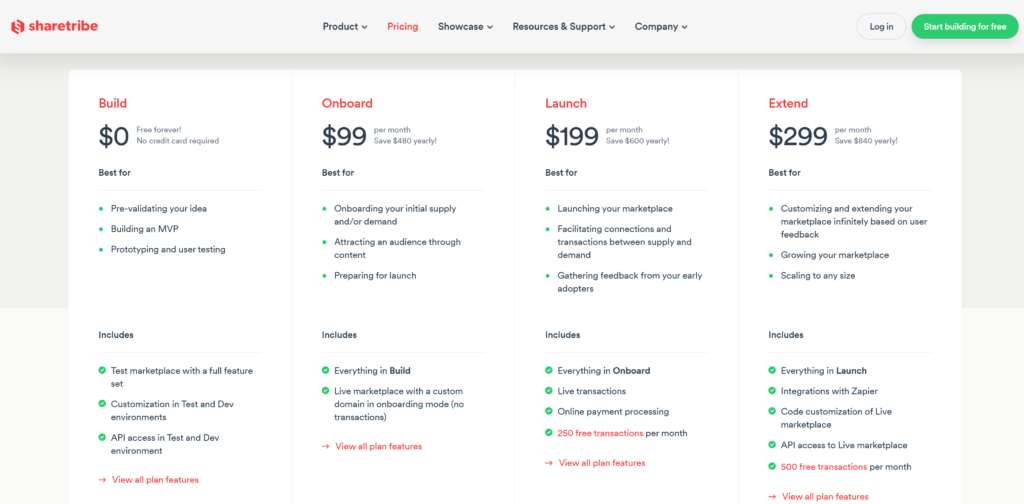
By contrast, Dittofi’s hosting model allows you to scale up or down your production environment based on your customer usage patterns. This means that you only pay for what you use & allows you to free up budget for other things & improve your overall profit margins. Furthermore, Dittofi offers you the chance to export your apps source code & run in your own hosting environment. This gives you complete price transparency for the cost of your marketplace hosting.
Lastly, Sharetribe is prone to price increases. This can make budgeting difficult & introduces a risk to your business that the cost of running your marketplace is more than the revenue it can generate.
Visual development studio
Both Dittofi & Sharetribe come with the ability to build a marketplace without having to write any code. However, Sharetribe’s visual development studio is highly limited compared to Dittofi.
Both Dittofi & Sharetribe break up their visual development studios into four main parts. These are:
- Structuring the database, which will hold all of the information that your marketplace users will input into the marketplace. For example, product, service or property listings.
- Composing the user interface, where you will create screens, buttons, input boxes that your marketplace users will interact with.
- Backend logic & business workflows, which, put simply, will determine what happens when a user clicks on a button in the frontend of your marketplace. For instance, when a user enters their credit card details & clicks “Pay Now”, money is transferred to an external payment processing provider e.g. Stripe & then held in escrow until the payout is made.
- Marketplace production hosting, for when you’re ready to take your no code marketplace live.
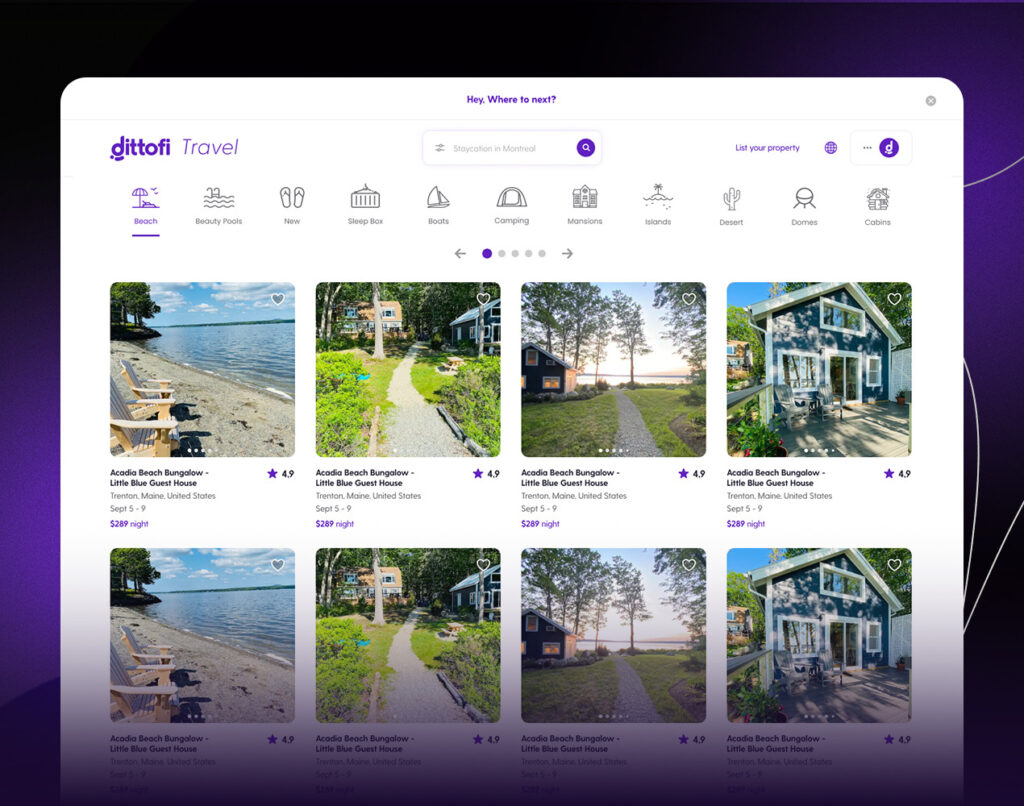
In contrast, Dittofi offers 100% customizable templates for product, rental & service marketplaces.
To get around the visual limitations of Sharetribe Go, Sharetribe offers Sharetribe Flex.
Sharetribe Flex allows developers to build custom frontends with custom code & to hack functionality on top of the Sharetribe backend. This will work however, it will require you to write code from scratch which is expensive, time consuming & error prone. Furthermore, if you use Sharetribe Flex, your marketplace intellectual property belongs to Sharetribe (more on this below).
Therefore, if you’re looking for a visual development solution that is faster than coding, Dittofi is a better solution, since you can build entirely custom marketplaces faster than coding whilst also getting access & ownership over your apps code.
Code export
One of the main limitations with all no-code platforms is vendor lock-in. Whilst some of the newer no-code platforms allow you to export your code; this feature does not help with vendor lock-in. This is because users are still locked-in to the vendors backend code & hosting to run their applications.
Sharetribe is no different.
With both Sharetribe Go & Sharetribe Flex, you do not own any of the intellectual property for your marketplace. Whilst it is true that Sharetribe Flex lets you build custom frontends on top of Sharetribe’s backend, Sharetribe’s backend is non accessible. Users are able to request new features on Sharetribe using their product board & report bugs to the Sharetribe community, but they will need to wait for Sharetribe’s development team to respond before getting the updates.
Furthermore, whilst it is true that Sharetribe does offer Sharetribe Flex as an entirely open source code repository. If you make changes to this code (A) you need to be a developer and (B) you cannot always push your changes into Sharetribe’s code repository. This means that any changes you make quickly get out of sync with the Sharetribe code repository.
Dittofi is still the only no-code platform that comes with zero vendor lock-in & the option for self hosting. The platform does this by giving you access to your app’s frontend & backend source code. This means that with Dittofi it is possible to build an entirely custom two-sided marketplace app that you actually own. In addition you are not dependent on Dittofi’s release cycles. Finally, using Dittofi’s visual development studio, you can make changes to the code in an entirely visual way & without having to write any code.
Self hosting options
Using Dittofi’s code export feature you can host your Dittofi marketplace software anywhere (AWS, Google Cloud, Microsoft Azure). This can be done through a manual code export & infrastructure setup, or with Dittofi’s Automated Devops Solution (ADS), that lets you deploy your app into your own infrastructure in a single click.
With Dittofi ADS, Dittofi automatically creates the hosting configuration for your app. Dittofi does this in accordance with best practices to ensure that your hosting is secure, reliable & performant. This automated infrastructure setup gives users something known as a “cloud native” approach to marketplace development. The cloud native approach is the way all major marketplaces work e.g. Airbnb, Etsy, Uber & so on.
Building a cloud native app normally takes 12 – 18 months to develop & will require difficult to source & highly expensive talent. However, with Dittofi you get all of this work in a single click.
A list of benefits for self hosting through Dittofi ADS include:
- Transparent pricing: Self hosting means that you will be charged directly by your hosting provider. Dittofi put no markup on the app hosting, we simply charge you for Dittofi ADS while you continue to use it.
- Secure: Dittofi ADS automatically creates your AWS hosting environment according to AWS security best practices. With Dittofi all data is automatically encrypted both in transit & at rest. Automatic solutions are applied for newly discovered operating system & code level vulnerabilities. Protection is applied for DDOS attacks, mobile threats & more.
- Reliable: As part of your base hosting setup, Dittofi ADS will deploy your app onto cloud services that offer 99.999999999% uptime guarantees. In addition to this, Dittofi has cloud technicians who can offer specialist support & hosting through our 24×7 help desk.
- Scalability: Dittofi ADS sets up your base infrastructure in an entirely elastic & serverless way. This means that your app will be able to scale without any limits. Furthermore, because the code is running inside your own hosting environment, Dittofi can help you optimize your hosting model as you scale. This can give you important cost savings when running your app for large numbers of users.
Marketplace solutions
Sharetribe offer a one size fits all marketplace solution. This marketplace solution is best for product marketplace & NOT for rental or service marketplaces. We say this because Sharetribe’s marketplace solution is missing critical functionality for rental & service marketplaces.
For example, there is no functionality to support service providers “details pages”. Details pages are important on service marketplaces because they allow service providers to advertise their services to buyers. Think about a marketplace like Upwork or Fiverr. If there was no way to view what an individual service provider does, then freelancers would struggle to sell their services & the marketplace would be very difficult to navigate.
Sharetribe also does not have the ability to view detailed reviews for the providers of rental property or services. The ability to review two-sided reviews is critical to building trust on your marketplace. Think how important the ability to view detailed reviews is on Airbnb for example.
In contrast, Dittofi provides three templates that have been optimized for product, services & rental marketplaces. Each of these marketplaces can be rapidly customized, with 100% flexibility, using Dittofi’s visual app builder & without writing any code.
Tech stack
Dittofi marketplaces run on a higher quality & more performant tech stack than Sharetribe. A comparison of the tech stacks are listed below.
Dittofi vs Sharetribe: Tech Stack Comparison Table
| Tech stack component | Dittofi | Sharetribe |
|---|---|---|
| Database | PostgreSQL | MySQL. |
| Frontend | React, Redux HTML5, CSS | N/A - For anything custom, you have to code your own |
| Backend code* | Google Go | Ruby on the Rails |
| Hosting | Fully serverless & elastic hosting powered by Amazon Web services. | Black box hosting powered by Amazon Web Services |
| Self hosting | Export your source code & host anywhere. Use Dittofi ADS to access infrastructure code (terraform). |
N/A - No option to export code or infrastructure code, but you can start with the Sharetribe open source & build your own environment to run this on. |
*The part of your technology stack that impacts the performance of your marketplace is the backend. Sharetribe uses the programing language Ruby on the Rails vs Dittofi which uses Google Go. To understand the differences between Google Go & Ruby, read Google Go vs Ruby on the Rails.
Security & data compliance
The diagram below shows the different parts of your technology stack. There is the end application (the marketplace), the data created by users of the marketplace & the infrastructure & software where your marketplace runs from & where your data is stored. Security & data compliance needs to be considered across your entire technology stack.
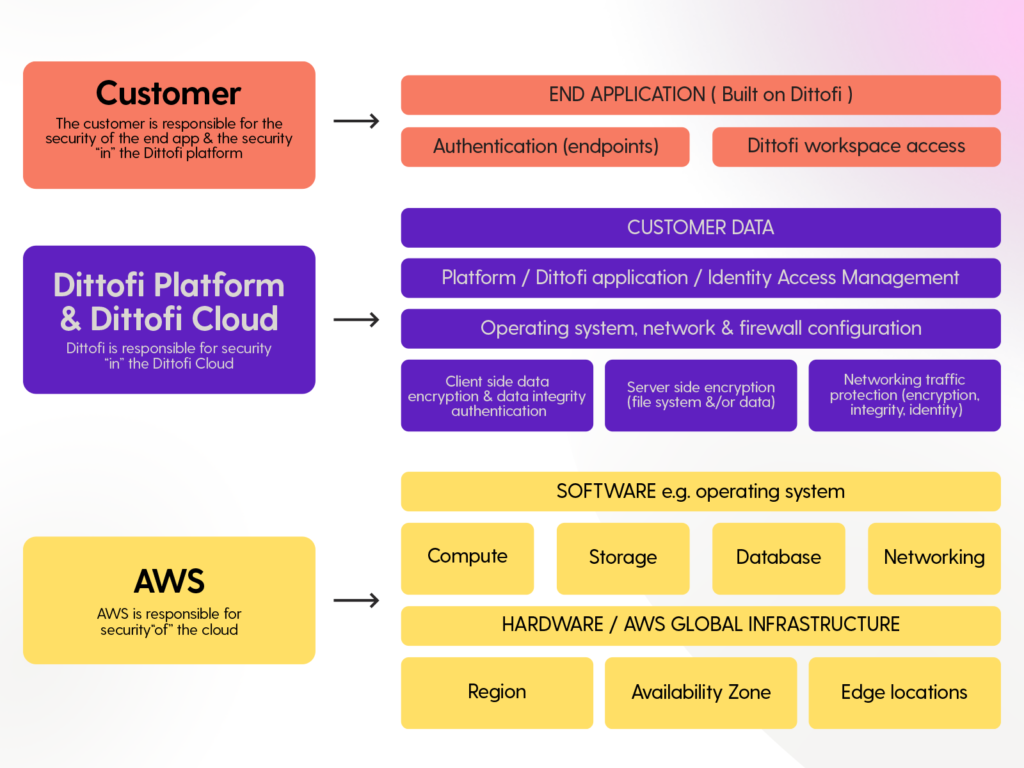
Dittofi offers a model of “shared responsibility”. The shared responsibility is between Amazon Web Services (AWS), Dittofi & the marketplace creator. This shared model can help to alleviate some of the operational load from the Dittofi client application since AWS operates, manages and controls the components from the host operating system & virtualization layer down to the physical security of the facilities in which the service operates. Meanwhile, Dittofi assumes responsibility & management of the operating system (including updates & security patches), as well as the configuration of the AWS provided security group firewall. The Dittofi end customer is then only responsible for the authentication & access management to their end Dittofi application. Dittofi also offers custom security options for clients who want to self host. In this case the customer can take control over the security “in” the cloud & host with different providers such as Google, Microsoft, other more niche hosting providers or in their own data centers.
In contrast to Dittofi’s model of “shared responsibility”, Sharetribe offers a “one size fits all” approach to security. This means that, with the above diagram, Sharetribe offers a standard configuration for the server-side data encryption, network traffic protection & so on.
The Sharetribe model is a good starting point & is relatively low cost when compared to developing your own secure application & hosting model. However, as your business grows, you will need more fine tune control over your apps code & infrastructure in order to remain compliant. Therefore, if you build with Sharetribe, you should expect to rebuild your marketplace at somepoint in the future.
Dittofi vs Sharetribe: Which is right for you?
Dittofi & Sharetribe both allow you to build a two-sided marketplace without writing any code. Both tools offer carefully developed marketplace solutions & offer extensive marketplace training.
Dittofi & Sharetribe differ primarily around the number of marketplace solutions on offer, the underlying tech stack, code export, security & the level of customization that users are able to quickly achieve.
On the one side, Sharetribe takes a one size fits all approach to marketplace development. They offer a visual studio which is quick to get started, but highly limited & a backend that requires a developer to customize. On the other side, Dittofi offers three marketplace templates that have been specifically designed for product, rental & service marketplaces. Each of these marketplaces can then be rapidly customized, with 100% flexibility & without writing any code.
Dittofi’s supports a high level of customization that spans the entire tech stack from app development through to hosting & ongoing developer operations that are essential as you scale.
Dittofi & Sharetribe both allow you to build a two-sided marketplace without writing any code. Both tools offer carefully developed marketplace solutions & offer extensive marketplace training.
Dittofi & Sharetribe differ primarily around the number of marketplace solutions on offer, the underlying tech stack, code export, security & the level of customization that users are able to quickly achieve.
On the one side, Sharetribe takes a one size fits all approach to marketplace development. They offer a visual studio which is quick to get started, but highly limited & a backend that requires a developer to customize. On the other side, Dittofi offers three marketplace templates that have been specifically designed for product, rental & service marketplaces. Each of these marketplaces can then be rapidly customized, with 100% flexibility & without writing any code.
Dittofi’s supports a high level of customization that spans the entire tech stack from app development through to hosting & ongoing developer operations that are essential as you scale.
Which solution is right for you depends on what you’re looking to achieve. Sharetribe Go gives you a very simple way to create a basic marketplace. Then at some point you will hire a developer & switch to Sharetribe Flex. Meanwhile Dittofi gives you a very simple way to create a more advanced & custom marketplace based on a powerful tech stack that you own & that can scale up as required.
Other Sharetribe alternatives include Magento, Yelo & Mirakl.
Try out Dittofi’s marketplace template solutions or schedule a call with our app consultants & learn how we can help you jump start your app build & get to market.
Become a Marketplace Insider
Join our inner circle for exclusive insights, coveted trade secrets, and unparalleled strategies – your journey to marketplace dominance begins here.

